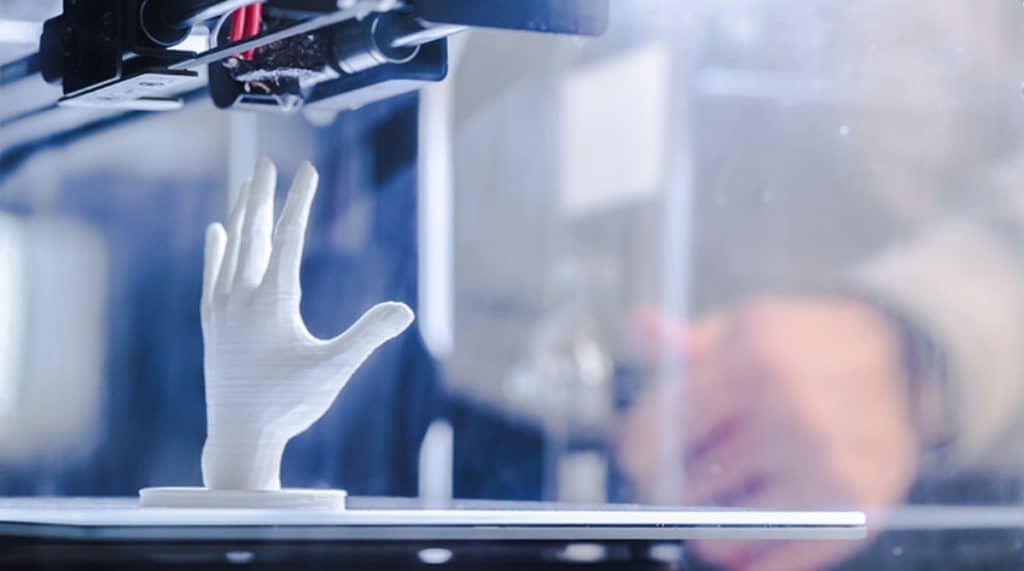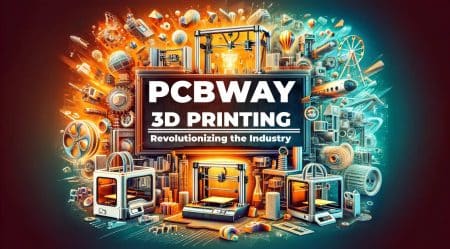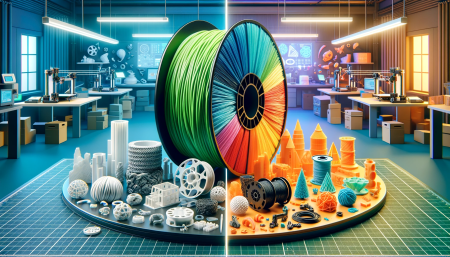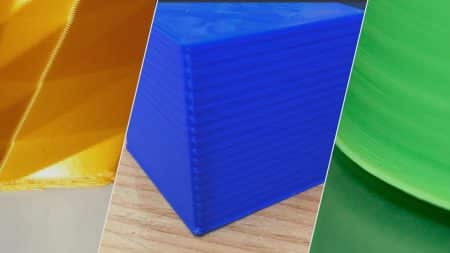The production of a three-dimensional object from a CAD or digital 3D model is known as 3D printing or additive manufacturing. It can be done in various ways. The material is deposited, connected, or solidified under computer control, and the material is placed together layer by layer (such as plastics, liquids, or powder grains being fused).
What is 3D Printing?
What is meant by “3D printing”? The term “3-dimensional printing” refers to several different procedures in which two-dimensional layers of material are deposited and combined one upon the next to generate three-dimensional things. This procedure, also known as additive manufacturing, is a fundamentally different method of generating parts than standard manufacturing technologies such as subtractive manufacturing or formative manufacturing.
How does a 3D printing work step by step?
3D printing always starts with a digital 3D model converted into an stl or obj file. This file is then sliced by the software with the 3D printer into thin two-dimensional layers and turned into a set of instructions known as a g-code for the 3D printer to carry out. From here, the 3D printer will continue to print the object. The operation of a 3D printer differs depending on the type of procedure being used. For instance, desktop FDM printers melt plastic filaments and lay them down onto the print platform through a nozzle. Whereas substantial industrial SLS printers do the opposite. Lasers are used in three-dimensional printers to liquefy successively thinner layers of powdered metal or plastic. Plastics are by far the most popular material used for 3D printing. Although it is possible to print metals as well, depending on the size of the object and the type of 3D printer. Completing a 3D print can take anywhere from four to eighteen hours. However, 3D printed objects frequently require some post-processing to attain the desired level of surface polish.
3D printing techniques were regarded only as adequate for manufacturing functional or aesthetic prototypes in the 1980s, and fast prototyping was a more fitting phrase. As of 2019, 3D printing’s precision, repeatability, and material range have improved. Some 3D printing techniques are now regarded as viable industrial-production technology. The term additive manufacturing is now interchangeable with 3D printing. One of the most significant advantages of 3D printing is creating extremely complicated shapes or geometries. That would be hard to make by hand, such as hollow pieces or parts with internal truss structures to minimize weight. As of 2020, the most common 3D printing technology is fused deposition modeling (FDM), which uses a continuous filament of a thermoplastic material.
How does 3D printing work?
Additive Manufacturing vs. Traditional Manufacturing

Because additive manufacturing has only been around since the 1980s, previous production methods are sometimes called “conventional.” Let’s divide all production methods into three categories to comprehend better the significant distinctions between additive and traditional manufacturing: additive, subtractive, and formative.
Additive manufacturing

By depositing and fusing 2D layers of material, additive manufacturing creates 3D objects.
One of the main advantages of 3D printing is that parts may be made in practically any geometry. This approach is perfect for prototyping because it requires little setup time or costs. Parts can be created quickly and discarded once they’ve been used.
One of the most significant drawbacks of 3D printing is that most parts are inherently anisotropic or not entirely dense. They lack the material and mechanical qualities of parts produced using subtractive or formative methods. Different prints of the same part are prone to subtle variances due to changes in cooling or curing conditions, limiting consistency and repeatability.
Subtractive manufacturing

Subtractive manufacturing, such as milling and turning, builds items by removing material (machining) from a solid block of material known as a ‘blank.’
It is a frequently utilized method since almost any material can be machined in some fashion. This approach can manufacture very accurate parts with excellent reproducibility due to the amount of control over every process stage. Most designs necessitate computer-aided manufacturing (CAM) to plan specific tool paths and efficiently remove materials. This increases setup time and costs but is the most cost-effective way of manufacturing for most designs.
The ability of the cutting tool to reach all surfaces to remove material is a crucial restriction of subtractive manufacturing, which severely limits design complexity. Due to the vast amounts of material removed to achieve the final part geometry, subtractive manufacturing is also a wasteful technique. While 5-axis machines remove some of these constraints, complicated pieces must still be re-oriented during the machining process, reducing time and cost.
Formative manufacturing

Formative manufacturing, which includes injection molding and stamping, produces products by shaping materials using heat and/or pressure.
Formative techniques are intended to lower the marginal cost of making individual parts. Still, constructing one-of-a-kind molds or equipment for manufacturing results in prohibitive setup costs. Regardless, these processes can produce parts in a wide range of materials (including metals and plastics) with near-perfect reproducibility. These advantages make them the most cost-effective option for high-volume production.
What are the differences between these methods?

Manufacturing is complicated, and there are far too many variables to compare each approach to all others. Cost, speed, geometric complexity, materials, mechanical qualities, surface polish, tolerances, and repeatability are nearly impossible to optimize.
Heuristics and rules of thumb are more useful in such complex situations:
Additive manufacturing is ideal when low volumes, sophisticated designs, and speed are required.
For medium volumes, simple shapes, strict tolerances, and rigid materials, subtractive manufacturing is the ideal option.
Formative manufacturing is ideal for massively producing similar items in large quantities.
Cost per part is frequently the deciding factor when deciding which manufacturing technique is ideal. The unit costs per method can be visualized as follows as a rough approximation:
How does a 3D printing work?
The technology of 3D printing
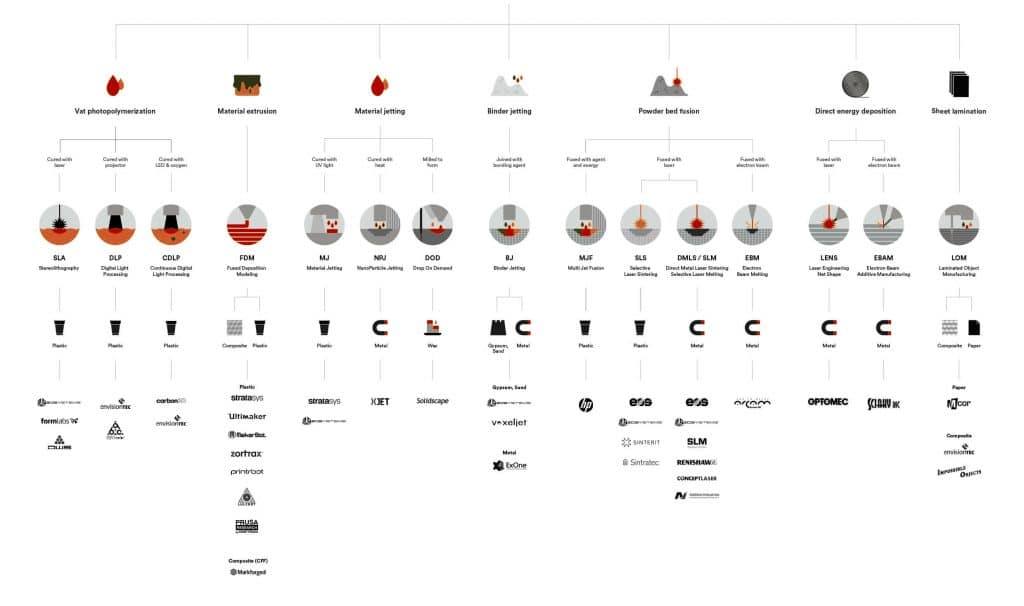
With so many various 3D printing technologies on the market, it can be challenging to keep track of everything. The ISO/ASTM standard 52900 was produced by the International Organization for Standardization to standardize the expanding terminology around 3D printing. And we’ve compiled the most commonly used terms into this dictionary of 3D printing terms.
So far, seven different types of additive manufacturing methods have been found and defined. These seven 3D printing techniques have spawned a plethora of 3D printing technologies currently used by 3D printers. In this article, we’ve tried our hardest to explain what they are and how they work.
How does a 3D printing work?
The types of 3D printing
- Vat Polymerization: Light is what causes the curing of liquid photopolymer.
- Material Extrusion: Thermoplastic material that has been heated and melted is deposited through a nozzle.
- Powder Bed Fusion: A source of intense energy that brings together the particles of a powder.
- Material Jetting: On top of a powder bed, droplets of a liquid photosensitive fusing agent are placed, and the powder is cured with light.
- Binder Jetting: On a bed of granulated materials, droplets of a liquid binding agent are applied, and the bed is then sintered to bring the components together.
- Direct Energy Deposition: Molten metal was both deposited and fused simultaneously.
- Sheet Lamination: After trimming to size, separate sheets of material are bonded together.
How Does Vat Photopolymerization 3D Printing Work?

Vat polymerization is a 3D printing technique in which a light source cures a photopolymer resin in a vat selectively. To put it another way, light is carefully directed to a specific place to harden a tiny layer of liquid plastic. Layer by layer, this process is continued until the 3D component is complete.
The light source used to cure the resin is the primary difference between different 3D printing technologies. Stereolithography (SLA), Digital Light Processing (DLP), and Masked Stereolithography (MSLA) are the three main types of vat polymerization. We go through each approach in detail below.
Some 3D printer manufacturers, particularly those that build professional-grade 3D printers, use slightly unique and patented forms of vat polymerization. Carbon uses a vat polymerization technology called Digital Light Synthesis (DLS), and Origin by Stratasys uses Programmable Photopolymerization (P3). Formlabs use Low Force Stereolithography (LFS). Azul 3D was the first to commercialize the high area rapid printing (HARP) form of vat polymerization. There’s also lithography-based metal manufacturing (LMM), projection micro-stereolithography (PSL), and Digital Composite Manufacturing (DCM). This filled-photopolymer technology introduces functional additives to liquid resin, such as metal and ceramic fibers. So you might see a variety of SLAs on the market.
https://youtu.be/pTsL-vcrAGA
Types of 3D Printing Technology
Stereolithography (SLA), masked stereolithography (MSLA), micro stereolithography (µSLA), and more.
What materials can be used in 3d printing?
Photopolymer resins (castable, transparent, industrial, biocompatible, etc.)
Benefits
- Smooth surface
- Fine details
- Suitable for prototyping of IM
Limitations
- Brittle
- Usually requires supports
- UV sensitive
- Extensive post-processing required
How Does Powder Bed Fusion 3D Printing Work?

Powder bed fusion is a 3D printing technique that uses a thermal energy source to selectively induce fusion between powder particles inside a build area to create a solid item.
Powder bed fusion devices use a blade or wiper to disperse a thin coating of powdered material across the print bed. Specific locations on the powder layer were fused with energy. Then another powder layer was deposited, and so on until the entire thing was created. The unfused powder is utilized to encapsulate and support the final product.
Types of 3D Printing Technology
Selective laser sintering (SLS), selective laser melting (SLM), electron beam melting (EBM), direct metal laser sintering (DMLS), Multi Jet Fusion (MJF)
What materials can be used in 3d printing?
Thermoplastic powders (Nylon 6, Nylon 11, Nylon 12, etc.), metal powders (steel, titanium, aluminum, cobalt, etc.), ceramic powders
Benefits
- Strong parts (nylon)
- Complex geometry
- Scalable (fits size)
- No support
Limitations
- Longer production time
- Higher cost (machines, material, operation)
How Does Material Extrusion 3D Printing Work?

Material extrusion refers to the process of extruding material through a nozzle. That substance is a plastic filament melted by being pushed through a heated nozzle most of the time. The printer deposits the material on a build platform along a preset path. The filament cools and solidifies to produce a solid object. Metal paste, bio gels, concrete, chocolate, and various materials can also be extruded, but plastics are the most popular.
Types of 3D Printing Technology:
Fused deposition modeling (FDM), sometimes called fused filament fabrication (FFF)
What materials can be used in 3d printing?
Plastic filament (PLA, ABS, PET, PETG, TPU, Nylon, ASA, PC, HIPS, Carbon Fiber, and many more.) and other material
Benefits
- Fast
- Low cost
- Common thermoplastics
Limitations
- Rough surface finish
- Anisotropic
- Usually requires supports
- Not scalable
- Limited accuracy
How Does Material Jetting 3D Printing Work?
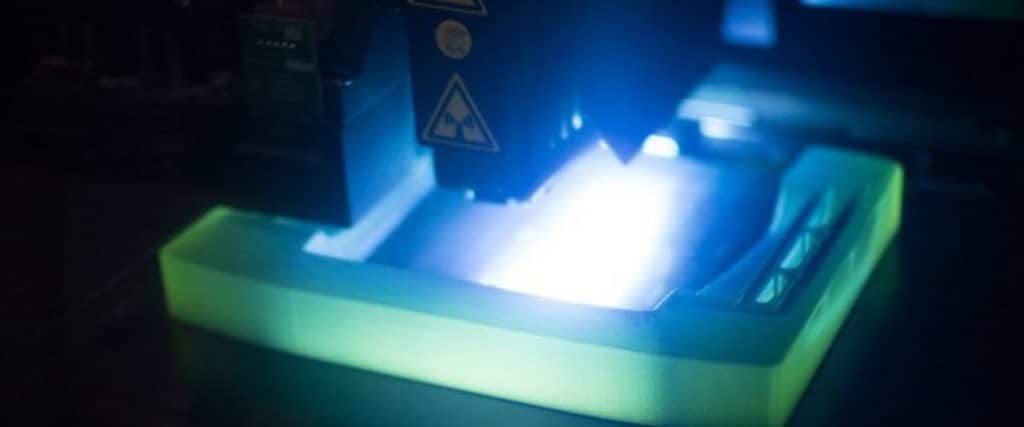
Material jetting is a 3D printing technique that involves depositing and curing droplets of material on a build plate. Objects are built up one layer at a time using photopolymers or wax droplets that cure when light exposure.
Different materials can be printed in the same object due to the nature of the material jetting process. Fabricating pieces in many colors and textures is one application of this method.
Types of 3D Printing Technology:
Material Jetting (MJ), Drop on Demand (DOD)
What materials can be used in 3d printing?
Photopolymer resin (Standard, Castable, Transparent, High Temperature)
Benefits
- Realistic prototypes
- Excellent details
- High accuracy
- Smooth surface finish
Limitations
- High cost
- Brittle mechanical properties
How Does Binder Jetting 3D Printing Work?
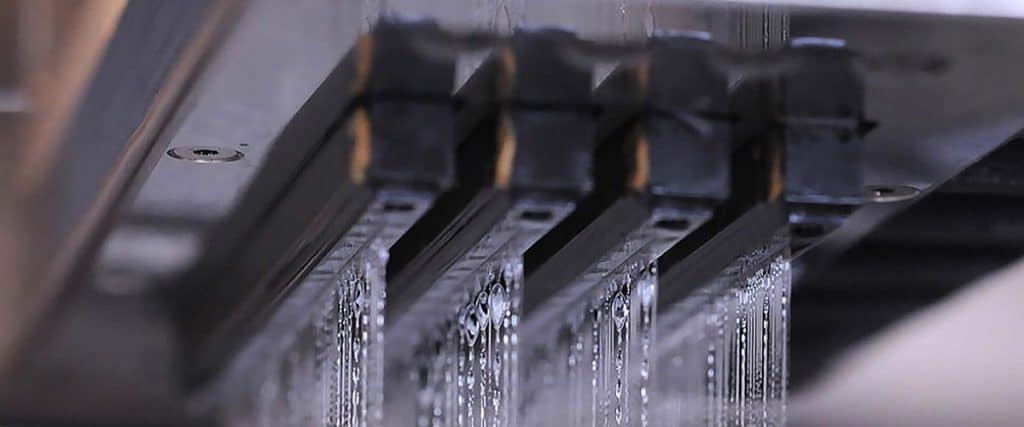
Binder jetting is a 3D printing technique that uses a liquid bonding agent to bind powder bed areas selectively.
Binder jetting is a 3D printing technique similar to SLS. It requires an initial coating of powder on the build platform. But unlike SLS, it does not use heat to sinter powder. Instead, it runs a print head over the powder surface, depositing binder droplets typically 80 microns in diameter. To make each layer of the item, these droplets glue the powder particles together.
The powder bed is lowered after each layer is printed. A new layer of powder is spread over the previously published layer. This procedure is done until the object is complete.
The object is then left to cure and acquire strength in the powder. After, it is taken out of the powder bed, and any loose powder is blown away with compressed air.
Types of 3D Printing Technology:
Binder jetting
What materials can be used in 3d printing?
Sand, polymer, or metal powder: Stainless / Bronze, Full-color sand, Silicia (sand casting); Ceramic-Metal composites
Benefits
- Full-color options
- Range of materials
- No support
- No warping or shrinking
Limitations
- Low part strength
- Less accurate than material jetting
How Does Direct Energy Deposition 3D Printing Work?

DED is a 3D printing technology in which material is simultaneously supplied and fused by intense thermal energy as it is deposited.
The three most common energy sources are electron beam, laser, or plasma. Material is fed into the heat source in wire or powder form, melting as it exits the nozzle and producing complicated shapes.
This technology can repair items and build a print layer by layer. As a result, DED is frequently utilized for repairs rather than for creating wholly new printed products.
When the material for this printing method is in powder form, it is usual practice to spray the powder with an inert gas (historically known as noble gases) to reduce or eliminate the potential of oxidation. There’s also the option of combining numerous powders to blend components and create diverse outputs with powder feedstock.
While the requirement for a large supply of inert gas may be considered a disadvantage of DED, the most serious flaw is that not all the material is used. Some powder will inevitably miss its mark and not melt. Another disadvantage of DED is that parts made this way often require a lot of post-processing.
Types of 3D Printing Technology
Laser Engineered Net Shaping (LENS); Electron Beam Additive Manufacturing (EBAM); Cold Spray
What materials can be used in 3d printing?
Metals, in wire and powder form
Benefits
- Strong parts
- Range of materials
- Larger parts
Limitations
- High cost
- Poor surface finish
How Does Sheet Lamination 3D Printing Work?

Sheet lamination is a type of 3D printing that creates a 3D item by stacking and laminating sheets of very thin material together. The material layers can be fused together in various ways, the most frequent of which are heat and sound. Paper, polymers, and metals are all utilized in sheet lamination. Therefore, which approach is best depends on the substance in question.
Parts created using this approach require a lot of post-production polishing, making it one of the less precise 3D printing technologies. As the print progresses, laser cutters and CNC routers are utilized to mold the print into the required shape, resulting in more waste than other 3D printing technologies.
Sheet lamination is used by manufacturers to make cost-effective, non-functional prototypes at a rapid rate. Because the materials used during the printing process can be swapped around, the technology can also be utilized to make composite goods. It’s worth noting that many objects made this way aren’t sturdy enough to be used as functional components and are better used as decorative items.
Types of 3D Printing Technology
Laminated Object Manufacturing (LOM), Ultrasonic Consolidation (UC)
What materials can be used in 3d printing?
Paper, polymer, and metal in sheet forms
Benefits
- Fast
- Low cost
- No support structures are necessary
- Multi-material layers
Limitations
- Post-processing is required
- Limited materials
- Finishing may vary
How does a 3D printing work?
A Short History of 3D Printing
Who invented 3D printing?

3D printing was developed to speed up industrial product prototyping. Chuck Hull’s 1984 Stereolithography Apparatus (SLA) is credited with inventing the 3D printer.
When was 3D Printing Invented?
Despite Chuck’s prominence, several technologies were invented in the late 1980s, and several companies were crucial to their development.
Hideo Kodama in Japan receives the first patent for a UV-curing photopolymer device. He built it for ‘rapid prototyping’ to make models and prototypes, but the patent was abandoned.
French inventors Alain Le Mehaute, Olivier de Witte, and Jean Claude André submitted a UV-curing photopolymer patent in 1984. GE abandoned the patent due to low business potential.
1984 – Only weeks following Le Mehaute, American Charles’ Chuck’ Hull submitted a patent for an ‘Apparatus for Production of Three-Dimensional Objects by Stereolithography,’ coining the phrase ‘stereolithography’ (SLA).
Hull invented STL and started 3D Systems in 1987.
1987 – Carl Deckard patented Selective Laser Sintering (SLS) and co-founded DTM Corp. (acquired by 3D Systems in 2001).
S. Scott Crump patents Fused Deposition Modeling (FDM) and founds Stratasys with his wife in 1989.
Commercialization
The late 1980s through the early 1990s saw rapid commercialization. First-generation machines were large and expensive. Their producers competed for industrial prototyping contracts with mass-market auto, aircraft, health, and consumer products manufacturers.
3D Systems releases the SLA-1, the first commercial SLA printer.
Stratasys received the FDM patent and released the 3D Modeler, the first FDM printer.
DTM releases the Sinterstation 2000, the first commercial SLS printer.
Electro-Optical Systems (EOS), founded in 1989, unveiled the first commercial metal 3D printer, the EOSINT M160.
Democratization
In the early 2000s, with severe profit competition, material science advancements, and numerous patents expired, 3D printing was cheap for the public. This was the decade that 3D printing became widespread, bringing manufacturing to the masses.
2005 – The open-source RepRap Project (for ‘Replicated Rapid Prototyper’) launches to build self-replicating 3D printers that can manufacture their own parts, skyrocketing interest in the technology.
2009 – Key FDM patents became public domain, and MakerBot released the ‘Cupcake CNC’ desktop 3D printer. It cost hundreds, not thousands, and all components were downloaded from Thingiverse.
Formlabs releases Form 1 with a record-breaking Kickstarter campaign that raises $2.95 million. Formlabs agreed with 3D Systems over patent infringement.
Hubs is a peer-to-peer 3D printing business that allows large transactions between buyers and sellers. It swiftly became the largest 3D printing platform globally with over 50,000 ‘hubs’ before focusing on aiding commercial customers by making custom manufacturing more accessible.
2014 – Key SLS patents became public domain, leading to smaller, cheaper SLS printers.
Maturity
In 2018, 3D printing enthusiasm faded from the media, but commercial uses for enterprises of all sizes rose. Thousands of companies produce printers and offer 3D printing services.
3D printing history
Most articles are entertaining. Wikipedia and Wohler Associates are great history resources.
3D printing (Wikipedia)
Wohlers 2016 Additive Manufacturing Report
Let us know in the comments below or on our Facebook page to let us know your ideas, and we would appreciate seeing pictures of your works of art!



